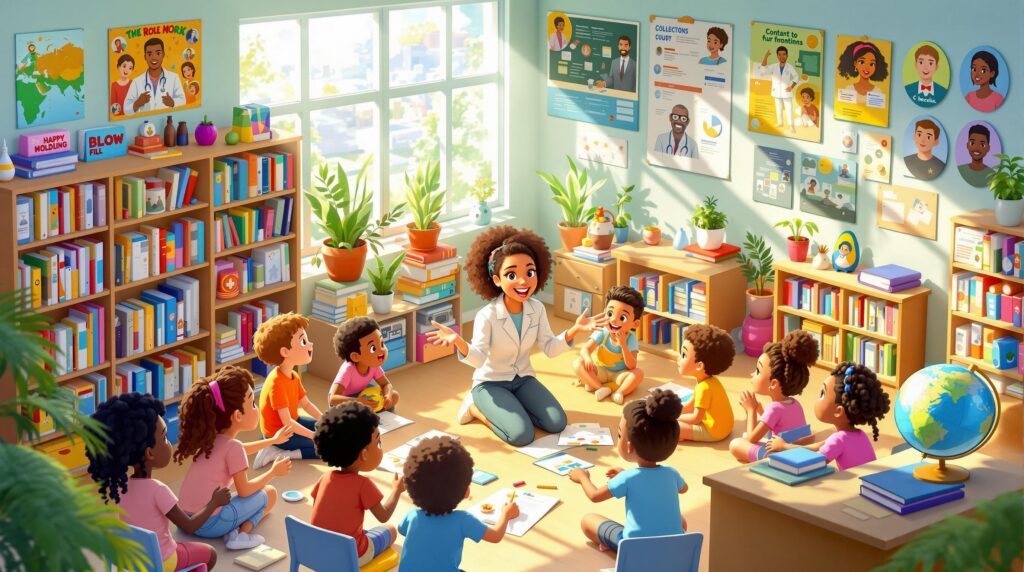Table of Contents
ToggleAs parents, we play a crucial role in shaping our children’s futures. But we’re not the only ones who influence their development. Role models, both within and outside the family, have a profound impact on how our kids grow, learn, and view the world. Let’s explore the vital role these influential figures play in our children’s lives and how we can harness their power for positive growth.
The Profound Impact of Role Models on Child Development
Role models significantly influence children’s behavior, values, and future choices. They serve as living examples of what’s possible, inspiring our little ones to dream big and work hard. The National Center for Education Statistics has found that positive role models improve children’s social and emotional development, setting the stage for success in various aspects of life.
The effects of having good role models in childhood extend far beyond the early years. Research shows that children who have positive role models during their formative years often experience better outcomes in adulthood. These benefits can include higher educational attainment, more stable relationships, and greater career success.

Identifying Your Child’s Role Models
Role models come in many forms, each contributing uniquely to a child’s development. Let’s examine some of the most influential figures in a child’s life:
Parents: The Primary Influence
As parents, we’re the first and most constant role models in our children’s lives. We shape their understanding of family values, work ethic, and interpersonal relationships. Our actions speak louder than words, so it’s crucial to embody the qualities we want our children to develop.
Teachers: Shaping Academic and Social Skills
Educators play a pivotal role in molding our children’s minds and characters. They not only impart knowledge but also demonstrate important social skills and learning attitudes. A great teacher can ignite a lifelong passion for learning and help children develop critical thinking skills.
Coaches and Community Figures
Sports coaches, religious leaders, and other community figures often teach valuable life lessons. They can instill a sense of teamwork, perseverance, and community responsibility. These role models expose children to diverse perspectives and experiences beyond their immediate family circle.
Media Personalities: A Double-Edged Sword
In today’s digital age, media figures wield significant influence over our children. While some can inspire and motivate, others may promote harmful behaviors or unrealistic expectations. The American Academy of Pediatrics stresses the importance of monitoring media consumption to ensure exposure to positive role models.
Building Self-Esteem and Confidence Through Positive Role Models
One of the most powerful effects of positive role models is their ability to boost a child’s self-esteem and confidence. Building confidence in kids is crucial for their overall development, and role models play a key part in this process.
The American Psychological Association reports that children with positive role models tend to have higher self-esteem and better mental health outcomes. This is because role models provide support, encouragement, and a blueprint for success.
For example, a parent who demonstrates resilience in the face of challenges shows their child how to persevere. A teacher who celebrates a student’s unique talents can help that child recognize and value their own strengths. A coach who encourages effort over outcome can instill a growth mindset, teaching kids that abilities can be developed through dedication and hard work.
Cognitive Development: Learning by Example
Role models play a crucial part in cognitive development by demonstrating problem-solving skills, critical thinking, and effective learning behaviors. This aligns with Jean Piaget’s theory of cognitive development, which emphasizes that children learn through observation and imitation.
In the home, parents can model curiosity and a love for learning by engaging in activities like reading, discussing current events, or taking on new hobbies. In the classroom, teachers can demonstrate different approaches to problem-solving, encouraging students to think creatively and persist through challenges.
Community role models, such as local entrepreneurs or scientists, can spark interest in specific fields by sharing their experiences and showcasing real-world applications of knowledge. This exposure can broaden a child’s horizons and inspire them to explore diverse areas of interest.
The Power of Social-Emotional Learning from Role Models
Role models are instrumental in teaching children crucial social-emotional skills such as empathy, cooperation, and conflict resolution. The Collaborative for Academic, Social, and Emotional Learning (CASEL) emphasizes the importance of role models in effective social-emotional learning programs.
Parents can model empathy by showing concern for others and discussing emotions openly. Teachers can facilitate cooperative learning experiences, demonstrating how to work effectively in teams. Coaches can teach sportsmanship, showing how to handle both victory and defeat gracefully.
By observing and interacting with these role models, children learn to navigate complex social situations, manage their emotions, and build positive relationships. These skills are crucial for success in school, work, and personal relationships throughout life.
Diversity in Role Models: Broadening Perspectives
Exposure to diverse role models is vital for broadening children’s perspectives and reducing stereotypes. Studies have shown that children who interact with role models from various backgrounds demonstrate reduced prejudice and improved social cohesion.
Parents can introduce diversity by exposing children to books, movies, and real-life examples featuring people from different cultures, abilities, and backgrounds. Schools can invite guest speakers from diverse professions and backgrounds to share their experiences. Community programs can facilitate interactions with people from different walks of life, fostering understanding and respect for diversity.
The Parent-Child Relationship: The Ultimate Role Model
As parents, we are the most significant role models in our children’s lives. Our actions, attitudes, and behaviors shape our children’s understanding of the world and their place in it. By modeling positive behaviors like respect, honesty, and kindness, we set the foundation for our children’s character development.
To be effective role models, we need to practice self-awareness and consistency. This means aligning our actions with our words and being mindful of how we handle stress, conflict, and challenges. It’s also important to admit our mistakes and show how to learn from them, demonstrating that growth and improvement are lifelong processes.
Teachers as Role Models: Inspiring Academic and Social Growth
Teachers have a unique opportunity to shape young minds both academically and socially. Research from the National Education Association has shown that positive teacher-student relationships are linked to higher academic performance and better social adjustment.
Beyond academics, teachers can model important life skills such as time management, organization, and effective communication. They can demonstrate a passion for learning that inspires students to cultivate their own intellectual curiosity. By creating a supportive and inclusive classroom environment, teachers also show students how to build positive relationships and resolve conflicts constructively.
Community Involvement: Expanding the Circle of Influence
Community figures such as coaches, mentors, and local leaders play a crucial role in expanding a child’s circle of positive influences. Programs like Big Brothers Big Sisters have demonstrated the positive impact of community mentorship on children’s social and emotional development.
Parents can encourage community involvement by supporting their children’s participation in sports, clubs, or volunteer activities. These experiences expose children to diverse role models and provide opportunities to develop new skills and interests. Community role models can offer unique perspectives and experiences that complement the influences of family and school.
Navigating Media Influence: Choosing Positive Role Models
In today’s media-saturated world, it’s crucial to help children critically evaluate the role models they encounter through various media channels. While media can introduce children to inspiring figures from around the world, it can also expose them to negative influences.
The American Academy of Pediatrics provides guidelines for managing children’s media exposure. Parents can use these recommendations to create a balanced media diet that includes positive role models. This might involve co-viewing media with children and discussing the behaviors and values portrayed.
Teaching children to think critically about media representations is also important. Encourage them to question unrealistic portrayals and discuss the difference between a media persona and real-life behavior. This skill will serve them well as they navigate an increasingly complex media landscape.
Fostering Long-Term Success: The Lasting Legacy of Role Models
The influence of childhood role models extends far into adulthood. Longitudinal studies have shown that positive role models in childhood are associated with better life outcomes, including higher educational attainment, career success, and overall life satisfaction.
Many successful individuals credit childhood role models for inspiring their achievements. For example, a scientist might trace their passion for discovery back to an encouraging teacher, or a social activist might attribute their commitment to justice to a parent who volunteered in the community.
To ensure positive role model influences throughout childhood, parents can:
- Consistently model the values and behaviors they want to see in their children
- Expose children to diverse role models through books, media, and real-life interactions
- Encourage relationships with positive adult figures such as teachers, coaches, and mentors
- Discuss the qualities that make someone a good role model
- Help children develop critical thinking skills to evaluate the behaviors they observe in others
By understanding the powerful impact of role models and actively cultivating positive influences in our children’s lives, we can set them on a path toward success, happiness, and fulfillment. Remember, every interaction is an opportunity to be a positive role model and to foster resilience in kids, shaping not just their present, but their future as well.
As we guide our children through the complex web of influences they encounter, let’s strive to surround them with role models who inspire growth, kindness, and a passion for learning. By doing so, we’re not just raising children; we’re nurturing the leaders, innovators, and compassionate citizens of tomorrow.
Sources:
National Center for Education Statistics
American Psychological Association
Collaborative for Academic, Social, and Emotional Learning (CASEL)
National Education Association
Big Brothers Big Sisters
American Academy of Pediatrics
U.S. Department of Education
National Institute of Child Health and Human Development (NICHD)












